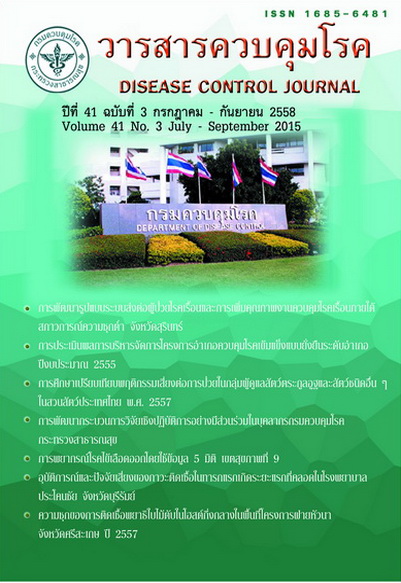Incidence and risk factors of early clinical neonatal sepsis in Prakhonchai Hospital, Buriram Province
DOI:
https://doi.org/10.14456/dcj.2015.16Keywords:
incidence, risk factors, early clinical neonatal sepsisAbstract
Background: Neonatal sepsis is one of the most common causes of neonatal mobility and mortality in the developing world. This objective of this study is to determine the incidence and risk factors of early clinical neonatal sepsis in Prakhonchai Hospital during the years 2012-2015. Methods: Unmatched case control study was performed to identify possible risk factors. Univariate and multivariate analyses were used to estimate crude odds ratio and adjusted odds ratio with 95% confidence interval. Result: There were 107 infants of early clinical neonatal sepsis out of a total 1,919 live births. Male:female ratio was 1:1.27, there is no death. The incidence of early clinical neonatal sepsis was 55.80 per 1,000 live births. The highest maternal age group was 20-35 years (74.10%) followed by <20 years (19.00%) and >35 years (6.90%). The highest priority of pregnancy was 1st pregnancy (46.20%) followed by 2nd pregnancy (32.30%), 3rd pregnancy (14.60%) and 4th pregnancy (6.90%). The highest symptoms was fever (50.80%) followed by jaundice (27.10%), low temperature (11.90%), respiratory complication (8.50%), respiratory rate >60/min (8.50%), and diarrhea (6.80%). In univariate analysis the significant factors was low birth weight (OR = 4.38, 95% CI = 1.59-12.03) and respiratory complication (OR = 12.60, 95% CI = 1.69-305.92). In multivariate analysis the only one significant factor that was low birth weight (adjusted OR = 4.52, 95% CI = 1.56-13.04). Conclusions: The high incidence of early clinical neonatal sepsis was found. Only one significant risk factor was low birth weight which may associated with low immunity and high risk to infection.
Downloads
References
2. Behrman R.E, Kleigman R, Jenson H.B. Nelson textbook of pediatrics. 17th ed. Saunders: Philadelphia; 2003.
3. ยิ่งรัก ปึงวงศานุรักษ์. อุบัติการณ์ภาวะติดเชื้อ ในทารกแรกเกิด ลักษณะทางคลินิกและการรักษาของทารกที่คลอดในโรงพยาบาลด่านชุนทด. วารสารศูนย์อนามัยที่ 5 2552;6:9-18.
4. โรม บัวทอง, สิกานต์ ขาวนวล, พัฒนสิริ สำราญพิศ, พิณรัตน์ พัวงามประเสริฐ, อมรรัฐ สุขใส, นิตยา มีเครือรอด, และคณะ. ปัจจัยเสี่ยงของการติดเชื้อในทารกแรกเกิด โรงพยาบาลกงไกรลาศ จังหวัดสุโขทัย 1 ตุลาคม 2548 - 30 กันยายน 2549. รายงานการเฝ้าระวังทางระบาดวิทยาประจำสัปดาห์ 2551; 30:525-29.
5. Leal YA, Alvarez-Nemegyei J, Velazquez JR, Rosado-Quiab U, Diego-Rodriguez N, Paz- Baeza E, et al. Risk factors and prognosis for neonatal sepsis in southeastern Mexico: analysis of a four-year historic cohort follow-up. BMC Pregnancy and Childbirth 2012;347:284-7.
6. Muhammad Matloob Alam, Ali Faisal Saleem, Abdul Sattar Shaikh, Owais Munir, Maqbool Qadir. Neonatal sepsis following prolong rupture of membrane in a tertiary care hospital in Karachi, Pakistan. J Infect Dev Ctries 2014;8:67-73.
Downloads
Published
How to Cite
Issue
Section
License
Articles published in the Disease Control Journal are considered as academic work, research or analysis of the personal opinion of the authors, not the opinion of the Thailand Department of Disease Control or editorial team. The authors must be responsible for their articles.






